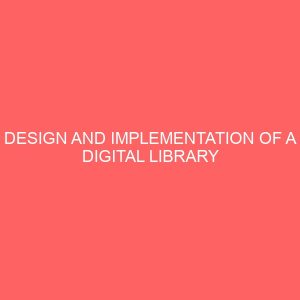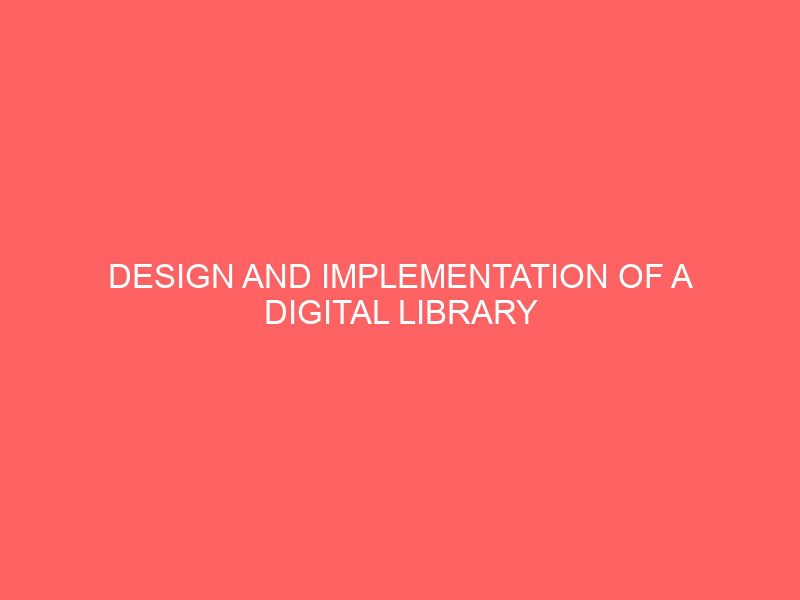Description
CHAPTER ONE
1.0INTRODUCTION
Digital Library System DLS extends and integrate approaches adopted in traditional libraries as well as in distributed information systems, to yield high-end information systems, services and institutions. Here we will explore some of the parts or components of digital libraries and discuss several of the developments in this emerging field.
Building a comprehensive digital library system will help users to manage all phases of the information lifecycle. Of particular importance is to simplify the authoring and creation process so that wider population can participate by adding all types of multimedia content directly into digital libraries. Downstream access allows readers to benefit from this type of computer-mediated communication, across time and space. Ultimately, it is believed that knowledge will be shared and then lead to yet another cycle of discovery, authoring and utilization that is facilitated by digital libraries.
1.1BACKGROUND OF THE STUDY
Times are fast changing; we now live in a jet age which is mainly characterized by rapid changes in technology, lifestyle and value. This is indeed an age of information explosion.
One of the major inventions that have driven the world to a fast pace of technological advancement is the computer. The computer is primarily an electronic information processor that is rapidly changing the way we acquire, organize, recall, access, analyze, synthesize and apply information. The effectiveness with which the information is generated and communicated determines the rate of progress of a society and the fulfillment of its people. Modern society is information driven and information today is a universal need.
Moreover, computers have affected the ways which people use information. It has changed the rate of work done, the method for accomplishing the work alongside the relationship among the people carrying and using the information. However, computers and libraries are not left out in the utilization of computer to carry out their daytoday activities especially as it concerns the amount of information generated. Libraries have evolved over the years which gave rise to digital libraries.
1.2STATEMENT OF THE PROBLEM
There are numerous problems with the traditional libraries. These inadequacies are enumerated below.
1.The users of the traditional library need to go the library physically which most times could lead to congestion of the library
2.Inability for the library resources to be accessed 24/7.
3.The library resources cannot be simultaneously used. It is one at a time.
4.Traditional libraries are limited by storage space.
1.3GENERAL OBJECTIVES OF THE STUDY
The proposed system Digital Library System has its general objectives which it is set out to achieve. They are as follows:
aTo create variety of access services for searching, browsing and discovering resources.
bTo organize and index digital objectives for different purpose which includes cataloging, finding aids and database.
cReduction of loan and acquisition through the use of digital library.
dComprehensive storage of large repository of data that can be accessed by authorized users.
eReduce the cost of maintaining a traditional library.
1.4SPECIFIC OBJECTIVE OF THE STUDY
The objectives of this proposed system has been narrowed. This is geared towards ensuring that the objectives are achieved. They are as follows:
Removal of Physical Bounding: Ensure that the users do not always go to the library physically, but can access library resource once he/she is connected to the server.
Round the Clock Availability: To enable users to be able to gain access 24/7 to the information.
Information Retrieval: To make it easy and convenient for the user to use any search term Title OR Authors name to search the entire collection, thus providing userfriendly interfaces, and giving clickable access to its resource.
Preservation and Conservation: Provide access to materials that would otherwise fall to degradation from repeated use.
Multiple Access: Ensure that the same resources can be used simultaneously by a number of persons.
Space: Able to provide storage for information digitally by using little physical space to contain them.
1.5SIGNIFICANCE OF THE STUDY
In implementing the objectives of this study, the advantages of a digital library over the traditional library are enormous. Users will be able to access library resource digitally without the inconveniences of users carrying books, journals, magazines etc. which could result in rapid wear and tear of this library resource. Besides, it will afford users the opportunity to access digital books simultaneously without waiting for the book to be returned to the library.
The proposed system will provide security to help track library resources through the development of a comprehensive database that will be used to house the library resources. The system will also eliminate some of the routine manual work prevalent in a traditional library.
1.6SCOPE OF THE STUDY
The findings of this research work for the proposed system Digital Library System was carried out in the Nnamdi Azikiwe University NAU in their digital library section. The scope of this study will include the following:
1.Information indexing/cataloguing.
2.Classification of library resource.
3.Searching and retrieval downloading.
4.Registration of books/uploading of digital resources
5.Registration of users.
6.Database management.
1.7LIMITATION OF THE STUDY
This proposed system will not take into consideration audio collections. It is web based not a stand alone delivery system with its own user file and login ID and password. Also, time constraint during the time for this project work is short. Financial resources is a limitation encountered in the course of this research work.
1.8DEFINITION OF RELATED TERMS
Digital: Relating to or using signals or information represented by discrete values of a physical quantity.
Library: A building or room containing collections of books, periodicals and sometimes films and recorded music for people to read, borrow or refer to.
Digital Library: Is a type of information retrieval system in which collections are stored in digital format.
Information: This is a collection of facts or data.








Reviews
There are no reviews yet.